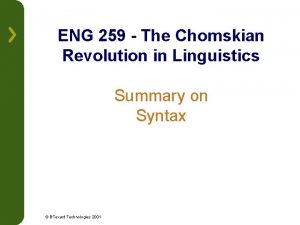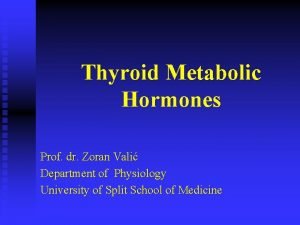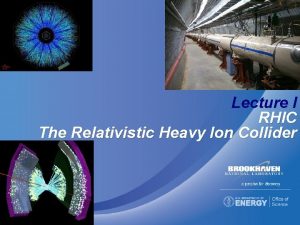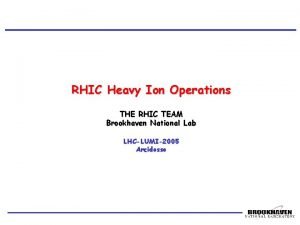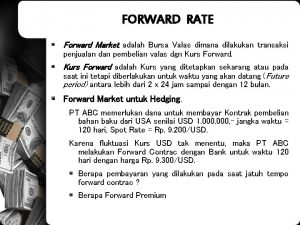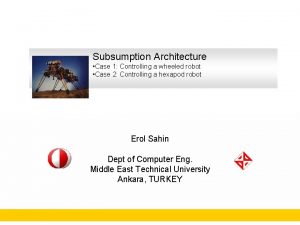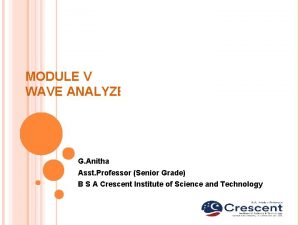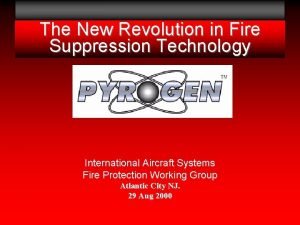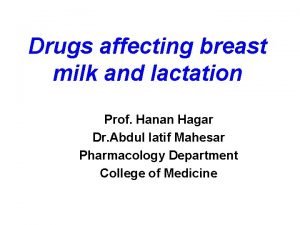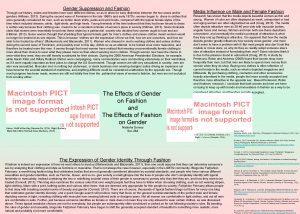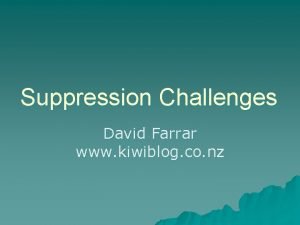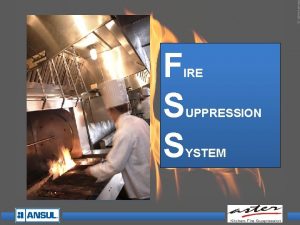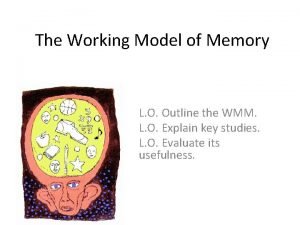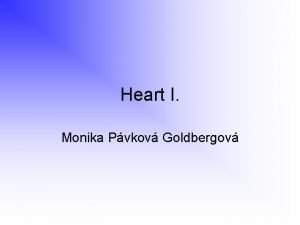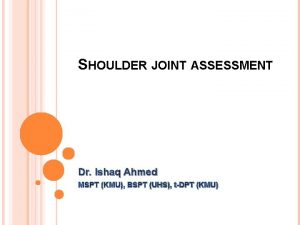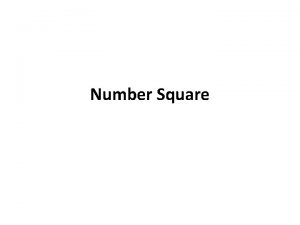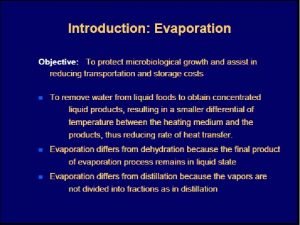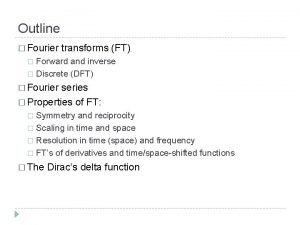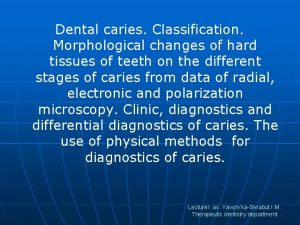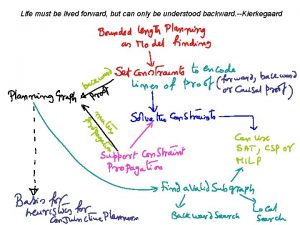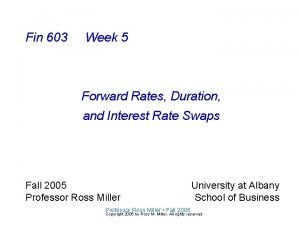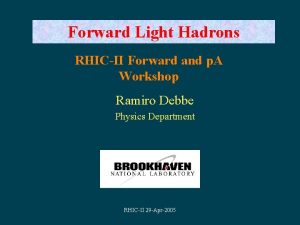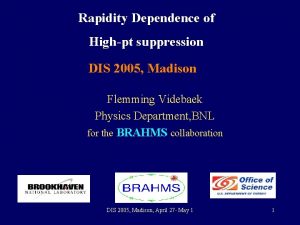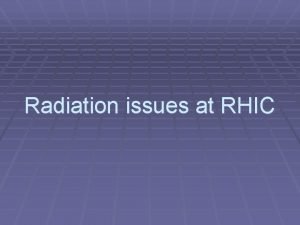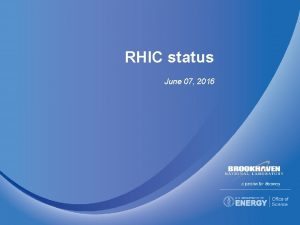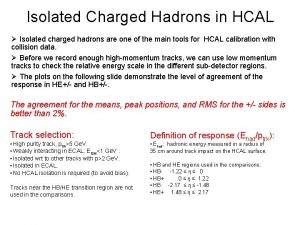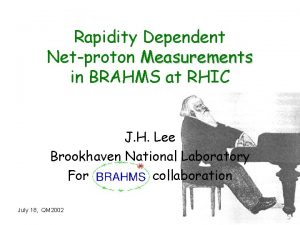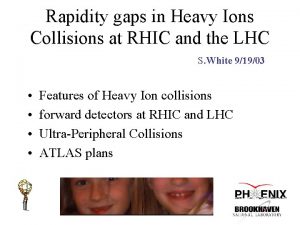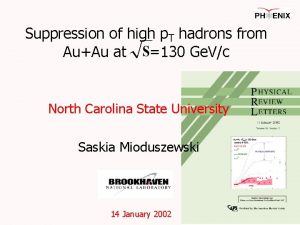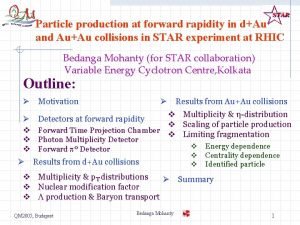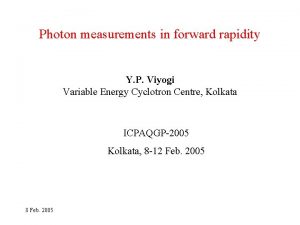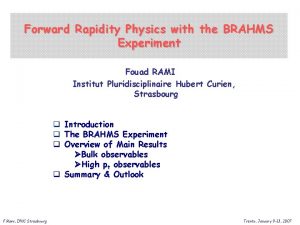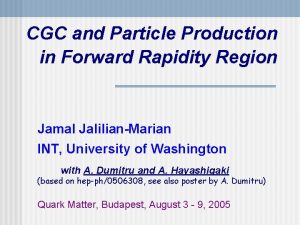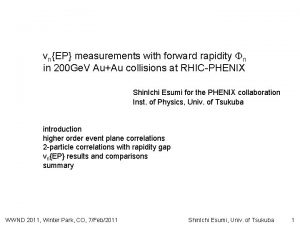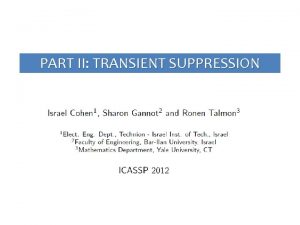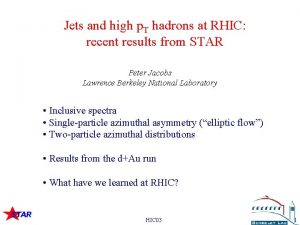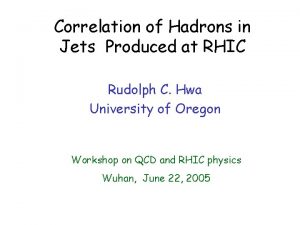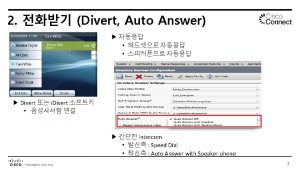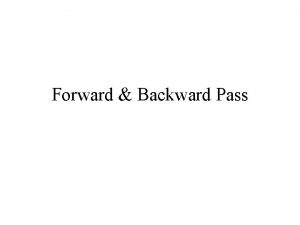Suppression of Hadrons at Forward Rapidity at RHIC




































- Slides: 36

Suppression of Hadrons at Forward Rapidity at RHIC M. Grosse Perdekamp, UIUC STAR 47 th Recontres De Moriond QCD and High Energy Interactions La Thulie March 10 h– 17 th 2012 Suppression of Hadrons at Forward Rapidity at RHIC Final State of a Au-Au Collision in STAR

Outline: Hadron Suppression at Forward Rapidities Initial State in HI Collisions o A-A Collisions at RHIC and the Initial State § Jet quenching, Elliptic flow, J/ψ o Studying the Initial State in d-A Collisions § Hadron cross sections, hadron pair correlations o Summary & Outlook: p-A at LHC and e-A at EIC observed final state initial state partonic matter Au hadronization Au time Suppression of Hadrons at Forward Rapidity at RHIC 2

J/ψ Production: Some Relevant Cold Nuclear Matter Effects in the Initial State (I) Shadowing (from fits to DIS data or model calculations) RGPb (II) Dissociation of into two D mesons by nucleus or co-movers (III) Gluon saturation from non-linear gluon interactions for the high gluon densities at small x K. Eskola H. Paukkumen, C. Salgado JHEP 0807: 102, 2008 DGLAP LO analysis of nuclear pdfs low x high x GPb (x, Q 2)=RGPb(x, Q 2) Gp (x, Q 2) Suppression of Hadrons at Forward Rapidity at RHIC 3

J/ψ : Most of the Suppression in A-A is from Cold Nuclear Matter Effects found in d-A Collisions EKS shadowing + dissociation: use d-Au data to determine break-up cross section EKS shadowing + dissociation: from d-Au vs Au-Au data at forward-rapidity mid-rapidity PRC 77, 024912(2008) Suppression of Hadrons at Forward Rapidity at RHIC 4

(III) cont’d The Color Glass Condensate see for example, F. Gelis, E. Iancu, J. Jalilian. Marian, R. Venugopalan, ar. Xiv: 1002. 0333 gluon density saturates for CGC: effective large an densities at field smalltheory: x: Small-x gluons are described as the Non-linear evolution color fields radiated byeqn. fast color sources at higher rapidity. This EFT describes the saturated gluons (slow partons) as a Color Glass Condensate. diffusion merging g emission The EFT provides a gauge g-g invariant, universal distribution, W(ρ): g-g merging if W(ρ) ~large probability to find a configuration ρ of color sources in a nucleus. saturation scale The evolution of W(ρ) is described by the JIMWLK equation. QS, nuclear enhancement ~ A 1/3 Suppression of Hadrons at Forward Rapidity at RHIC 5

CGC Expectations for Nuclear Modification of Hadron Cross Sections in d-Au Collisions Nuclear Modification Factor: Rd. A CGC-based expectations Kharzeev, Kovchegov, and Tuchin, Phys. Rev. D 68: 094013, 2003 rapidity, y gluon saturation at low x Rd. Au decreases at forward rapidity measure Rd. Au for different hadrons: h+, -, π0, J/ψ p. T Suppression of Hadrons at Forward Rapidity at RHIC 6

BRAHMS d+Au Cross Sections Decrease with Increasing Rapidity and Centrality Rd. Au BRAHMS, PRL 93, 242303 Hadron production is suppressed at large rapidity consistent with saturation effects at low x in the Au gluon densities CGC Similar results from PHOBOS, STAR and PHENIX Suppression of Hadrons at Forward Rapidity at RHIC 7

Theory vs Data CGC J. Albacete and C. Marquet, PLB 687, 184 p+p d+Au Not bad! However, different K factors for h+, - in BRAHMS and π0 in STAR Suppression of Hadrons at Forward Rapidity at RHIC 8

Theory vs Data Cronin + Shadowing + E-loss I. Vitev, T. Goldman, M. B. Johnson, JW. Qiu, Phys. Rev. D 74 (2006) Not bad either! Rd. A results alone do not uniquely demonstrate gluon saturation. Competing explanations can account for observed hadron suppression in d-Au at forward rapidity ! Suppression of Hadrons at Forward Rapidity at RHIC 9

Probing for Gluon Saturation Effects with Hadron-Hadron Correlations in d+Au dilute parton system -- d dense gluon field -- Au p. T is balanced by many gluons jet with trigger hadron jet with associated hadron Idea: Presence of dense gluon field in the Au nucleus leads to scattering of multiple gluons and parton can distribute its energy to many scattering centers Mono-jet signature ! D. Kharzeev, E. Levin, L. Mc. Lerran, Nucl. Phys. A 748: 627 -640, 2005 Experimental signature: Angular correlation between hadrons in opposing hemispheres widening of correlation width of d-Au compared to pp reduction in associated yield of hadrons on the away site Effects large at low x forward rapidity forward EMC upgrades in STAR : 2 < η < 4 PHENIX : 3. 1 < |η| < 3. 8 Suppression of Hadrons at Forward Rapidity at RHIC 10

PHENIX Muon Piston Calorimeter Technology ALICE(PHOS) Pb. WO 4 avalanche photo diode readout 3. 1 < η < 3. 9, 0 < φ < 2π -3. 7 < η < -3. 1, 0 < φ < 2π Both detectors were installed for 2008 d-Au run. Pb. WO 4 + APD + Preamp Assembly at UIUC Acceptance: MPC integrated in the piston of the muon spectrometer magnet. Suppression of Hadrons at Forward Rapidity at RHIC

Use of Forward Calorimeter for the Measurement of di-Hadron Correlations merged p 0 s PHENIX central spectrometer magnet ϕ Muon Piston Calorimeter (MPC) d p 0 mid-fwd xgluon ~ 10 -2 fwd-fwd xgluon ~ 10 -4 -10 -3 trigger EM -cluster 3. 1<η<3. 9 Au asssociated 0 3. 1 asssociated p p 0 or EM-clusters <3. 1 η <<3. 9 η < 3. 9 MPC Pb. WO 4 trigger p 0 or h+/|η|<0. 35 Backward direction (South) Forward direction (North) Side View Suppression of Hadrons at Forward Rapidity at RHIC 12

mid-fwd Conditional Yield Correlated Npair Di-Hadron Conditional Yield CY and Jd. A Df Di-Hadron Nuclear Modification factor Sgl-Hadron Nuclear Modification factor Possible indicators of nuclear effects Jd. A < 1, Rd. A < 1 ( only mono-jets Jd. A ~ 0 ) angular de-correlation of widths Suppression of Hadrons at Forward Rapidity at RHIC 13

STAR 2008 d-Au π0 Forward - Forward Correlations pp data (rad) Strong azimuthal broadening from pp to d. Au for away side, while near side remains unchanged. (rad) d. Au data s(d. Au)-s (pp)=0. 52± 0. 05 Suppression of Hadrons at Forward Rapidity at RHIC 14

Comparison to CGC Prediction CGC prediction for b=0 (central collisions) by Cyrille Marquet Nucl. Phys. A 796: 41 -60, 2007 d. Au Central Strong suppression of away side peak in central d. Au is consistent with CGC prediction Suppression of Hadrons at Forward Rapidity at RHIC 15

PHENIX for Central PHENIXJJd. A Strong vs xfrag Suppression no Suppression for Collisions at Low xfrag Peripheral ! ! Forward-Forward Trig p. T: 1. 1 -2. 0 Ge. V/c Mid-Forward 60 -88% (Peripheral) Trig p. T: 0. 5 -7 Ge. V/c 0 -20% (Central) Back-to-back hadron (jet) suppression is large at low-x for central collisions mono-jet like ? ! CGC ? Shadowing + E-loss? PHENIX Phys. Rev. Lett. 107 (2011) 172301 Note: points for mid-fwd Jd. A are offset for visual clarity Suppression of Hadrons at Forward Rapidity at RHIC 16

Jd. A vs p. QCD, Shadowing and Energy Loss Z. -B. Kang, I. Vitev, H. Xing ar. Xiv: 1112. 6021 Jd. Au p. QCD + shadowing + initial and final state energy loss Jd. A < 1 is not a unique CGC signature Suppression of Hadrons at Forward Rapidity at RHIC 17

Leading Order Jd. A ~ RGAU Mid-Forward-Forward Eskola , Paukkunen, Salgado, JHP 04 (2009)065 60 -88% (Peripheral) 0 -20% (Central) b=0 -100% Q 2 = 4 Ge. V 2 EPS 09 NLO gluons x. Au High x, mostly quarks Weak effects expected Low x, mostly gluons Suppression of Hadrons at Forward Rapidity at RHIC Jd. A ~ RGAu 18

Summary & Future Steps Towards GA(x) and knowing the Initial State of HI Collisions o RHIC data on single and di-hadron suppression suggest large nuclear effects in the initial state of HI collisions. o A detailed theoretical analysis of the available data yet has to be carried out. o Next: Hadron and Jet measurements in p-Pb at the LHC o Future: GA(x) measurements at an electron-ion collider e+A whitepaper (2007) Precise extraction of GA(x, Q 2) from FL measurements at EIC will be able to discriminate between different models e. RHIC: 10 Ge. V + 100 Ge. V/n - estimate for 10 fb-1 Suppression of Hadrons at Forward Rapidity at RHIC 19

Backup Slides Suppression of Hadrons at Forward Rapidity at RHIC 20

Why Study Nuclear Effects in Nucleon Structure in Particular the Nuclear Gluon Distribution GA(x) ? General interest: Heavy Ion Collisions: • Extend Understanding of QCD into the nonperturbative regime of high field strengths and large gluon densities. • Understand the initial state to obtain quantitative description of the final state in HI-collisions. • Search for universal properties of nuclear matter at low x and high energies. • Establish theoretical framework to describe initial state of HI-collisions based on measurements of GA (x) in p/d-A or e-A. Suppression of Hadrons at Forward Rapidity at RHIC 21

Jet Quenching: Initial State Saturation of GA(x) or QGP Final State Effect ? Quantify nuclear effects in hadron production Nuclear modification factor: RAA PHENIX RAu. Au and Rd. Au for π0 Two explanations for RAu. Au < 1 (from 2002 Au-Au and 2003 d-Au runs) Rd. Au ~ 1 (I) suppression of nuclear GA (x) (II) final state effects of strongly interacting partonic matter Control measurement of Rd. Au ~ 1 final state effect! RAu. Au < 1 Suppression of Hadrons at Forward Rapidity at RHIC 22

Elliptic Flow v 2 : Choice of Initial State GA(x) has Large Impact on Hydro Calculations PHOBOS v 2 vs Hydro Calculations Color Glass Condensate Brodsky-Gunion-Kuhn Model Phys. Rev. Lett. 39: 1120 T. Hirano, U. Heinz, D. Kharzeev, R. Lacey, Y. Nara Phys. Lett. B 636: 299 -304, 2006 Knowledge of the initial state is important for the quantitative interpretation of experimental results in heavy ion collisions! Suppression of Hadrons at Forward Rapidity at RHIC 23

Probing Low x with Correlation Measurements for Neutral Pions PYTHIA p+p study, STAR, L. Bland Trigger forward p 0 Forward-forward di-hadron correlations reach down to <xg > ~ 10 -3 FMS TPC Barrel EMC FTPC asso gives handle on xgluon With nuclear enhancement xg ~ 10 -4 Suppression of Hadrons at Forward Rapidity at RHIC

Alternative Explanation of Rapidity-Separated di-Hadron correlations in d+Au Complete (coherent + multiple elastic scattering) treatment of multiple parton scattering gives suppression of pairs with respect to singles for mid-rapidity tag! However, small forward trigger particle! J. Qiu, I. Vitev, Phys. Lett. B 632: 507 -511, 2006 Suppression of Hadrons at Forward Rapidity at RHIC

STAR The STAR FMS Upgrade and Configuration for Run 2008 see A. Ogawa H 2, Sunday 11: 57 BEMC: -1. 0 < < 1. 0 TPC: -1. 0 < < 1. 0 FMS: 2. 5 < < 4. 1 Forward Meson Spectrometer (FMS) Pb-glass EM calorimeter ~x 50 more acceptance Suppression of Hadrons at Forward Rapidity at RHIC

Id. Au from the PHENIX Muon Arms p. Ta, h+/- Observations at PHENIX using the 2003 d-Au sample: p. Tt, hadron – Left: Id. A for hadrons 1. 4 < |h| < 2. 0 , PHENIX muon arms. correlated with h+/- in |h| < 0. 35, central arms. – Right: Comparison of conditional yields with different trigger particle pseudo-rapidities and different collision centralities No significant suppression or widening seen within large uncertainties ! 0 -40% centrality 40 -88% centrality Id. A Trigger p. T range Id. A p. Taassociated Phys. Rev. Lett. 96 (2006) 222301 Suppression of Hadrons at Forward Rapidity at RHIC

MPC Pion/Cluster Identification • • The MPC can reliably detect pions (via p 0 g g) up to E =17 Ge. V To go to higher p. T, use single clusters in the calorimeter – Use p 0 s for 7 Ge. V < E < 17 Ge. V – Use clusters for 20 Ge. V < E < 50 Ge. V Correlation measurements are performed using p 0 s, clusters Use event mixing to identify pions: foreground photons from same event background photons from different events Foreground 12 < E < 15 Background N Yield Minv (Ge. V/c 2) Suppression of Hadrons at Forward Rapidity at RHIC South MPC

MPC Pion Selection • Cuts – Cluster Cuts • Cluster ecore > 1. 0 (redundant w/ pion assym and energy cuts) – Pi 0 pair • E > 6 Ge. V • Asym < 0. 6 • Separation cuts to match fg/bg mass distribution • Max(dispx, dispy) < 2. 5 • Use mixed events to extract yields – Normalize from 0. 25 -0. 4 presently Suppression of Hadrons at Forward Rapidity at RHIC 29

MPC/CA Cuts • • • MPC pi 0 ID – Mass window of 0. 1 -0. 2 Ge. V + previously shown cuts – 7 – 17 Ge. V energy range – Max(dispx, dispy) <= 2. 5 Charged Hadron ID Track Quality == 31 or 63 – n 0 <0 Rich cut – p. T < 4. 7 Ge. V – pc 3 sdz and sdphi matching < 3 – -70 < zed < 70 EMC pi 0 – Alpha < 0. 8 – Pb. Gl min E = 0. 1, Pb. Sc min E = 0. 2 – Chi 2 cut of 3, prob cut of 0. 02 – Sector matching – Mass window 0. 1 -0. 18 – Trigger bit check Suppression of Hadrons at Forward Rapidity at RHIC 30

Similar Results from STAR, PHENIX and PHOBOS PRL 94, 082302 Suppression in the d direction and enhancement in the Au fragmentation region d x 1 Au x 2 x 1 >> x 2 forward particle, xg = x 2 0 Suppression of Hadrons at Forward Rapidity at RHIC

STAR Run 8 FMS : π0 Forward - Forward Correlations pp data (rad) Strong azimuthal broadening from pp to d. Au for away side, while near side remains unchanged. d. Au data (rad) s(d. Au)-s (pp)=0. 52± 0. 05 Suppression of Hadrons at Forward Rapidity at RHIC

Centrality Dependence d. Au all data d. Au peripheral d. Au central Azimuthal decorrelations show significant dependence on centrality! Suppression of Hadrons at Forward Rapidity at RHIC

Comparison to CGC prediction for b=0 (central) by Cyrille Marquet Nucl. Phys. A 796: 41 -60, 2007 d. Au Central Strong suppression of away side peak in central d. Au is consistent with CGC prediction Suppression of Hadrons at Forward Rapidity at RHIC

CGC Calculations K. Tuchin ar. Xiv: 09125479 d. Au pp d. Au-peripheral Suppression of Hadrons at Forward Rapidity at RHIC d. Au-central 35

EIC: 4 Key Measurements in e+A Physics • Momentum distribution of gluons in nuclei? Extract via scaling violation in F 2 Direct Measurement: FL ~ x. G(x, Q 2) Inelastic vector meson production Diffractive vector meson production • Space-time distribution of gluons in nuclei? Exclusive final states Deep Virtual Compton Scattering F 2, FL for various impact parameters • Role of colour-neutral (Pomeron) excitations? Diffractive cross-section Diffractive structure functions and vector meson productions Abundance and distribution of rapidity gaps • Interaction of fast probes with gluonic medium? Hadronization, Fragmentation Energy loss CGC EFT: will it be possible to carry out a global analysis of RHIC d+A, LHC p+A and EIC e+A to extract W(ρ) and thus demonstrate universality of W(ρ) ? Suppression of Hadrons at Forward Rapidity at RHIC 36
 Hadrons
Hadrons Tg grammar
Tg grammar Rapidity of cerebration
Rapidity of cerebration Rhic ags users meeting 2020
Rhic ags users meeting 2020 Rhic
Rhic Orbital revolution
Orbital revolution Rhic brookhaven
Rhic brookhaven Forward rate dan forward market
Forward rate dan forward market Currency forward market
Currency forward market Foam suppression system
Foam suppression system Reinforced robot humor suppression pump
Reinforced robot humor suppression pump Heterodyne wave analyzer
Heterodyne wave analyzer Fire suppression rating schedule
Fire suppression rating schedule Fire suppression
Fire suppression Pyrogen aerosol fire suppression system
Pyrogen aerosol fire suppression system Cephalosporins
Cephalosporins Suppression clothes
Suppression clothes Hyperpigmentation in cushing syndrome
Hyperpigmentation in cushing syndrome Superegooo
Superegooo Nz entertainer name suppression
Nz entertainer name suppression Piranha fire suppression system
Piranha fire suppression system Novec vs inergen
Novec vs inergen Articulatory suppression
Articulatory suppression Nitin ventures fze
Nitin ventures fze Heart cross section
Heart cross section Acromioclavi
Acromioclavi Count forward
Count forward Evaporator diagram
Evaporator diagram Poma software engineering
Poma software engineering Semi forward chassis diagram
Semi forward chassis diagram Community pharmacy forward view
Community pharmacy forward view Forward and inverse fourier transform
Forward and inverse fourier transform Gj mount classification
Gj mount classification Forward chaining and backward chaining example
Forward chaining and backward chaining example Life lived forward
Life lived forward What is forward cover
What is forward cover How to calculate forward premium
How to calculate forward premium

